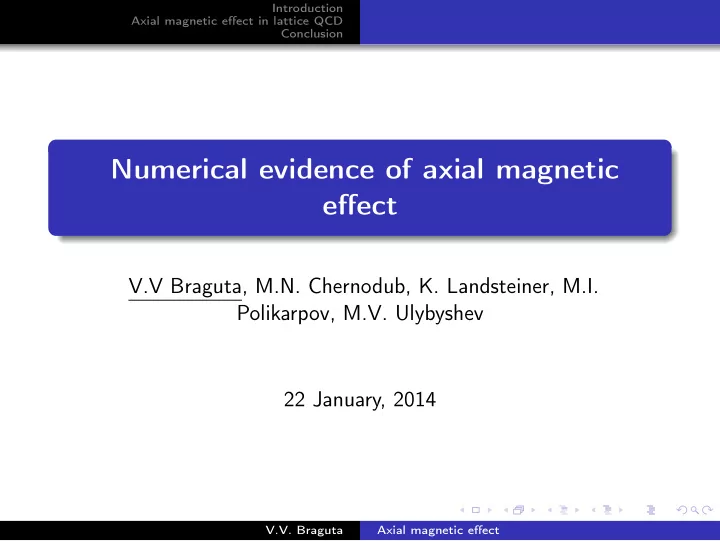

Introduction Axial magnetic effect in lattice QCD Conclusion Numerical evidence of axial magnetic effect V.V Braguta, M.N. Chernodub, K. Landsteiner, M.I. Polikarpov, M.V. Ulybyshev 22 January, 2014 V.V. Braguta Axial magnetic effect
Introduction Axial magnetic effect in lattice QCD Conclusion Outline: Introduction Axial magnetic effect in lattice QCD Conclusion V.V. Braguta Axial magnetic effect
Introduction Axial magnetic effect in lattice QCD Conclusion Chiral magnetic effect Topological charge( n R � = n L ) + magnetic field ⇒ chiral magnetic effect (D. Kharzeev, L. McLerran, H. Warringa, NPA 803 (‘08) 227) Related to axial anomaly J V = σ AV H can be studied experimentaly ( observed at RHIC and LHC, STAR Collaboration Phys.Rev.Lett. 103 (2009) 251601, ...) V.V. Braguta Axial magnetic effect
Introduction Axial magnetic effect in lattice QCD Conclusion Anomalous transport µ A Chiral magnetic effect: J V = σ VV H , σ VV = 2 π 2 µ Axial chiral magnetic effect: J A = σ AV H , σ AV = 2 π 2 σ V = µ A µ Chiral vortical effect: J V = σ V ω, 2 π 2 µ 2 + µ 2 + T 2 A Axial chiral vortical effect: J A = σ A ω, σ A = 4 π 2 12 Why anomalous transport phenomena are so interesting? Can be seen in current heavy ion collision experiments Related to the first principles of quantum field theory (anomalies) Non-dissipative phenomena V.V. Braguta Axial magnetic effect
Introduction Axial magnetic effect in lattice QCD Conclusion Axial chiral vortical effect: σ A = T 2 Axial chiral vortical effect: J A = σ A ω, 12 ( µ = µ A = 0 ) Axial magnetic effect: A a t a − ie γ 5 ˆ L = ¯ � ˆ ∂ − ig ˆ � ψ A 5 ψ σ = σ A = T 2 J i ǫ = � T 0 i � = σ H 5 , 12 V.V. Braguta Axial magnetic effect
Introduction Axial magnetic effect in lattice QCD Conclusion Lattice simulation of QCD Allows to study strongly interacting systems Based on the first principles of quantum field theory Acknowledged approach to study QCD Very powerful due to the development of computer systems Aim: lattice study of axial magnetic effect V.V. Braguta Axial magnetic effect
Introduction Axial magnetic effect in lattice QCD Conclusion From axial magnetic to usual magnetic field 5 = ∂ µ − igA µ − ie γ 5 A µ 2 � ¯ J E = � T 0 i � = i ψ ( γ 0 D i 5 + γ i D 0 5 ) ψ � , D µ 5 C µ ( x , y , A 5 ) = � ¯ � � ψ ( x ) U xy γ µ ψ ( y ) � = − Tr U S 5 ( A 5 ) γ µ � � � � Tr S 5 ( A 5 ) γ µ = Tr ( P R + P L ) S 5 ( A 5 ) γ µ = � P R S ( A 5 ) γ µ � + Tr � P L S ( − A 5 ) γ µ � Tr The motion in axial magnetic field can be related to the motion in usual magnetic field V.V. Braguta Axial magnetic effect
Introduction Axial magnetic effect in lattice QCD Conclusion Free fermions ( P. V. Buividovich, arXiv:1309.4966 ) Theoretical result for free fermions can be reproduced in lattice QCD V.V. Braguta Axial magnetic effect
Introduction Axial magnetic effect in lattice QCD Conclusion Simulation details Tadpole improved action SU(2) quenched QCD Statistics 900 + 900 + 900 Lattice parameters: L s = 14 − 20 , L t = 4 − 6 , β = 3 . 0 − 3 . 5 V.V. Braguta Axial magnetic effect
Introduction Axial magnetic effect in lattice QCD Conclusion Quarks in quenched SU(2) QCD ( V. Braguta et. al., Phys.Rev. D88 (2013) 071501 ) First lattice observation of non-dissipative phenomenon J ǫ ∼ H 5 σ lat ( T = 1 . 58 T c ) = 2 . 2 × 10 − 3 GeV 2 σ lat ( T = 1 . 58 T c ) is by an order of magnitude smaller than σ th ( T = 1 . 58 T c ) V.V. Braguta Axial magnetic effect
Introduction Axial magnetic effect in lattice QCD Conclusion Quarks in quenched SU(2) QCD JE C AME = eH 5 T 2 � � h Good fit: C AME ( T ) = C ∞ AME exp − T − Tc C AME ( T > T c ) > 0 C AME ( T < T c ) = 0 Clean signature of axial magnetic effect in experiments V.V. Braguta Axial magnetic effect
Introduction Axial magnetic effect in lattice QCD Conclusion Conclusion First lattice observation of non-dissipative phenomenon σ lat is by an order of magnitude smaller than σ th Clean signature of axial magnetic effect in experiments V.V. Braguta Axial magnetic effect
Introduction Axial magnetic effect in lattice QCD Conclusion THANK YOU V.V. Braguta Axial magnetic effect
Recommend
More recommend